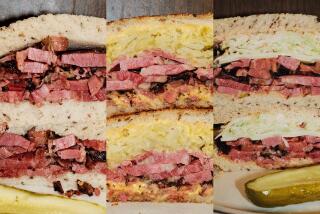Simplicity Ain’t Easy
When you go to Nadia Santini’s restaurant to talk about food, it can take quite a while to get to the kitchen. It’s not that the restaurant is so big--in fact, it’s a converted home and still has an intimate feel. Neither is the kitchen stuck in some out-of-the-way part of the building. It’s front and center and relatively spacious, with huge picture windows looking out over the neighboring corn fields.
It takes a long time to get to the kitchen because Nadia Santini cannot talk about cooking without beginning in her garden. That is, after all, where her cooking begins.
Santini is a small, demure woman, but she has the quiet command of a schoolteacher or a librarian. With her husband, Antonio, and her mother-in-law, Bruna, she runs Dal Pescatore, one of the best restaurants in Italy despite being tucked away in a relatively little-traveled area midway between Milan and Venice.
It’s a part of Italy that looks like Indiana might have if it had been settled by the Lombards. Two-lane roads, endless cornfields, dairy farms and then, almost incongruously, those big fortress-style stone farmhouses you remember from Bertolucci movies.
Dal Pescatore is one of those, perched on a high, wooded bank above the little river piquantly named Oglio (a cross between oil [olio] and garlic [aglio], perhaps?).
The garden is in back, terraced down to the river. Here the family (her father-in-law, Giovanni, also helps) grows the lettuces, tomatoes, herbs, celery, squash and eggplant they use in the restaurant. That’s not much of a surprise. But that they also grow their own saffron reveals the depth of their obsession. That’s a strong word, but there is really no other way to explain the family’s passionate belief in the importance of simple, local food.
Mother-in-law Bruna, who at seventysomething still makes all of the fresh pastas and risottos, insists that the 9-foot willow branch, collected from one of the trees that line the river and stripped of its bark, is the only acceptable wood--perhaps in all of Italy--on which to dry her noodles. Any other wood, she says, gives the pasta a salty taste. This wood is sweet.
The linchpins of Nadia’s cooking are celery and a metal skewer. She calls them her two best friends. Celery, she says, particularly the kind of scrawny looking, powerfully flavored stuff she grows in her garden, reduces the need for salt in food and lends a more complex flavor. It seems to go into almost everything she cooks.
The skewer is for testing the doneness of meat. There are a lot of roasts on the menu at Dal Pescatore, and all are first cooked on the stove in a pan with water--the amount varies on what Nadia senses to be the “wetness” of the meat. Beef takes very little water. Goat takes a lot. When the water evaporates, the meats brown in their own juices. When an order comes in, Nadia cuts off a portion and warms it in the oven.
That’s the way most of her cooking goes. It’s almost like perfect versions of those three-ingredient recipes. For a terrine of tomatoes, she layers peeled, split and seeded plum tomatoes in a dish lined with sauteed eggplant. The strained juice from the tomatoes is barely thickened with gelatin and poured over everything to bind it. Chilled and sliced, the terrine is garnished with the unopened buds of basil flowers that explode with flavor when you bite them (as soon as you can see some flower, Nadia says, the buds are too bitter). The flavors are sublime; the textures of silk and flesh almost erotic.
A ravishing dish of veal livers and porcini mushrooms is made by sauteeing chunks of porcini in a little butter and then adding liver. About two minutes before serving, a sprig of rosemary is added. Liver, butter, mushroom, rosemary. The result--at once intensely animal and woodsy--could make you cry.
So, you think, how hard can this be? Well, just try it. And then, if you’re like me, try it again and again and again. Somehow the flavors never quite come in tune. The lovely clarity is fuzzed. What was limpid and fragile in Nadia’s kitchen in mine seems to become forced and rough.
How can food this simple be so difficult to reproduce? The answer is at once simple and incredibly difficult. It comes from the right ingredients, carefully chosen and carefully grown. It comes from three generations of perfecting the same dishes and 20 years of cooking them night after night. It comes from an intimate knowledge of the area and its culture. It comes from split-second technical control.
It’s the last day before the three-week summer break, and the restaurant will be packed. The Michelin people ran the wrong closing date in their guide, and since the cognoscenti learned that they had an extra week of eating, they’ve been storming the gates.
Nadia is in the garden when the phone rings. Antonio yells down from the second floor to ask if they can somehow fit in just one more person.
“No!” she answers, heading inside to talk to him. “We cannot add one more table. There is just no room.”
She returns a couple of minutes later, looking a little sheepish. “Well, we have the waiting area where we can set up one table,” she says.
“It is a pianist who is giving a concert in Mantova. This is his only open night in the whole tour. Can you imagine an artist like that? How hard he has worked? How can you not feed him when he asks?”
ZUCCHINI AND PORCINI RISOTTO
This is based on something I had at Dal Pescatore this summer. It is not one of Nadia Santini’s recipes. In fact, after three or four tries at perfecting it, I’d say it’s not even close. But it is a nice fall dinner dish and that will have to be good enough for us mortals. Using water instead of broth for some risottos is one trick I learned from the Santinis. It lets the flavor of the other ingredients shine more. You will have to add a little more salt than is normally necessary to make up what is normally absorbed from the broth.
1/2 pound zucchini
Salt
10 grams dried porcini mushrooms
1/4 pound plum tomatoes
1 whole clove garlic, peeled
1 stalk celery, minced
1 tablespoon chopped parsley
1/4 cup (1/2 stick) butter
3 cups short-grain rice, preferably Vialone nano or Arborio
1 cup dry white wine
2 tablespoons minced chives
1 teaspoon torn mint leaves
* Trim ends of zucchini and place in bowl with cold, lightly salted water to cover. Soak 30 minutes.
* Combine dried mushrooms and just enough hot water to cover in small bowl. Soak until mushrooms soften, about 20 minutes (place another small bowl on top to weight mushrooms until they’ve absorbed enough water to sink on their own).
* Bring 2 quarts water to boil in large pot. Cut shallow “X” in bottom of tomatoes and add to boiling water. Cook 30 seconds, remove and rinse under cold water. Peel tomatoes, cut in half and squeeze out seeds and chop coarsely. Keep water near boil.
* Shred zucchini on grater or in food processor. Drain mushrooms and squeeze dry, reserving soaking water for making soup. Chop mushrooms fine.
* Cook garlic, celery, parsley and 2 tablespoons butter in large skillet over medium heat until celery softens, about 5 minutes. Add rice and cook, stirring, until rice “sings” dryly when stirred across bottom of pan, about 3 minutes. Add white wine and cook, stirring, until it evaporates.
* Begin adding boiling water to skillet, 1 cup at a time. Cook until each addition of liquid has evaporated, stirring to keep from sticking. After 3 cups of water, add shredded zucchini. Add 1 more cup water and cook down. Add mushrooms and tomatoes and begin adding water 1/2 cup at a time. Total water will be about 5 cups.
* When rice is still slightly chewy but not at all chalky, remove from heat, add remaining 2 tablespoons butter, chives and mint and stir vigorously for 1 minute to mix. Season to taste with salt--it will take about 1 teaspoon because of the lack of broth--and serve immediately.
6 entree or 8 appetizer servings. Each appetizer serving: 355 calories; 146 mg sodium; 16 mg cholesterol; 6 grams fat; 63 grams carbohydrates; 7 grams protein; 0.66 gram fiber.
More to Read
Eat your way across L.A.
Get our weekly Tasting Notes newsletter for reviews, news and more.
You may occasionally receive promotional content from the Los Angeles Times.











